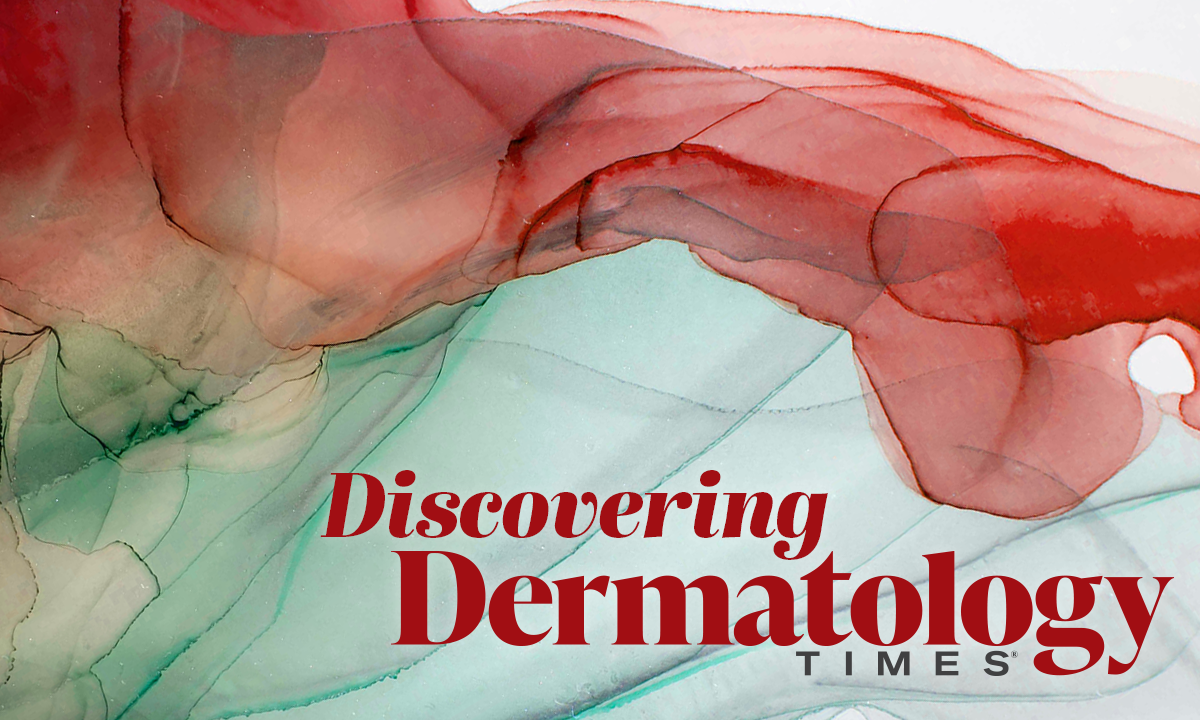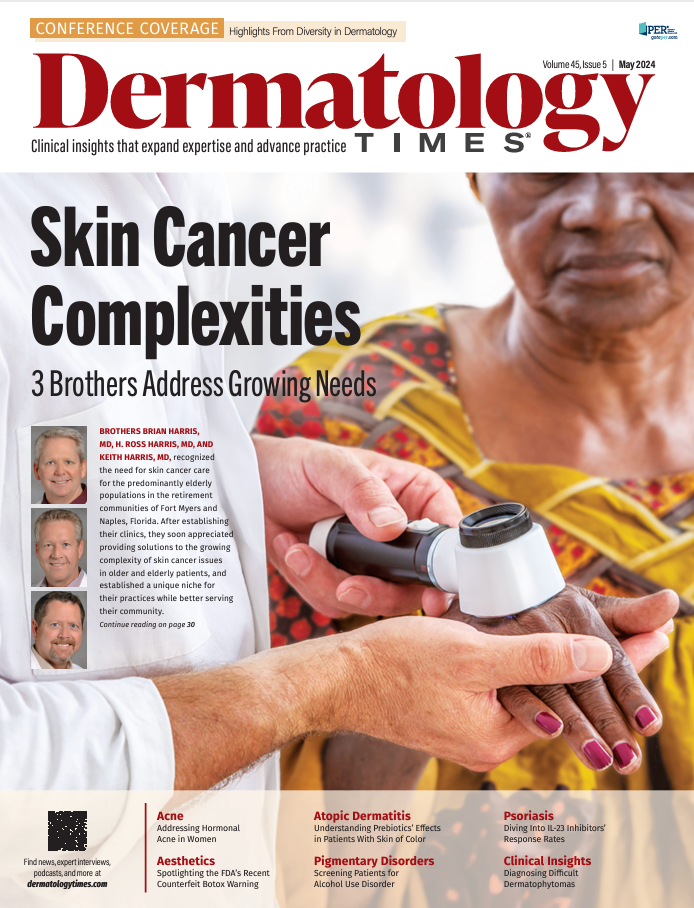- Case-Based Roundtable
- General Dermatology
- Eczema
- Chronic Hand Eczema
- Alopecia
- Aesthetics
- Vitiligo
- COVID-19
- Actinic Keratosis
- Precision Medicine and Biologics
- Rare Disease
- Wound Care
- Rosacea
- Psoriasis
- Psoriatic Arthritis
- Atopic Dermatitis
- Melasma
- NP and PA
- Skin Cancer
- Hidradenitis Suppurativa
- Drug Watch
- Pigmentary Disorders
- Acne
- Pediatric Dermatology
- Practice Management
- Prurigo Nodularis
- Buy-and-Bill
Publication
Article
Dermatology Times
Discovering Dermatology Times: May 2024
Author(s):
Learn more about the in-depth topics covered in the May 2024 print issue of Dermatology Times.

The May issue of Dermatology Times includes a collection of thought-provoking articles and topics ranging from skin cancer and Mohs surgery insights from Harris Dermatology to the surface area of IL-23 inhibitor's epitopes influencing psoriasis response rates. Be sure to take a look at highlights from the issue below. Also, don’t miss a moment of Dermatology Times by signing up for our eNewsletters and subscribing to receive the free print issue and supplement each month.
The Growing Complexity of Skin Cancer Care
Fort Myers and Naples, Florida, are distinguished by miles of stunning coastline and hubs for those looking to rest, relax, and retire. Brothers Brian Harris, MD, H. Ross Harris, MD, and Keith Harris, MD, recognized the need for exclusive skin cancer care for predominantly elderly populations and they dedicated their careers to education, detection, Mohs surgery, and more by establishing skin cancer clinics there. In this issue, they are reflecting on the significance of Melanoma and Skin Cancer Awareness Month year-round and share clinical pearls to best serve patients with skin cancer.
“It’s quite a personal relationship we have with this type of cancer,” H. Ross Harris told Dermatology Times. “Multiple family members—our parents and other brothers and sisters in our family—have all experienced [skin cancer]. I think 5 of us have had cutaneous melanoma. When we get to relay how important skin cancer detection and early detection in particular [are] to the public, it’s not only the professional side of us, it’s personal as well.”
Prebiotic Skin Care’s Effectiveness in AD for SOC Patients
Our study design consisted of 140 patients, of whom 50% had skin of color, presenting with mild atopic dermatitis (AD) or severe xerosis, aged 3 to 80 years old and from different racial/ethnic backgrounds. All patients were instructed to use La Roche-Posay’s Lipikar AP+ Gentle Foaming Cleansing Oil alone for 2 weeks followed by Lipikar AP+M Moisturizing Cream in conjunction for an additional 8 weeks.
There were 3 key takeaways from our new study:
- Our prebiotic cleanser and moisturizer regimen offered strong benefits in reducing both severe xerosis and mild AD severity, by decreasing skin roughness, improving appearance, strengthening skin barrier properties on both normal and lesional skin, and by promoting better quality of life by significantly reducing itch sensation as early as 2 weeks.
- Performing subanalysis, separating patients of color vs White counterparts, we observed that patients of color with AD experienced greater itching sensation than White counterparts, while White patients with xerosis perceived worse quality of life vs patients with skin of color counterparts at baseline.
- By implementing SkinCam, we successfully captured quality clinical images of xerosis and AD (clinically diagnosed with same severity levels) in patients with multiple skin tones and monitored improvement over time with our prebiotic skin care regimen.
Dermatophytoma: A Diagnosis That You Do Not Want to Miss
Dermatophytoma is a common yet highly underrecognized onychomycosis subtype that was first described by Roberts and Evans in the British Journal of Dermatology in 1998. Roberts and Evans described the clinical findings as a “dense white linear area or a round white area,” and when they clipped back the onycholytic area, they observed a “thick hyperkeratotic mass” that was not adherent to the nail plate and could be easily removed. The authors described the histopathology of the clipping as a “densely packed clump of dermatophyte hyphae, which are thick walled and somewhat abnormal looking.” They coined the term dermatophytoma, and likened it to an aspergilloma, which is also comprised of densely packed fungal elements. Roberts and Evans hypothesized that a nail unit dermatophytoma would have the same treatment implications as treatment of a lung aspergilloma, and that antifungal penetration and drug concentrations would be inadequate for a complete cure. Roberts and Evans recommended surgical removal of the nail plate, akin to surgical excision of a lung aspergilloma.
Surface Area of IL-23's Epitope Influences Short- and Long-Term Responses for IL-23 Inhibitors in Plaque Psoriasis
A recent scientific investigation published in JID Innovations examined the structural composition of IL-23-binding epitopes to better understand how their molecular properties relate to the clinical efficacy of IL-23 inhibitors for the treatment of plaque psoriasis. Daniele et al investigated risankizumab, tildrakizumab, and guselkumab, which bind the IL-23 p19 subunit, as well as ustekinumab, which binds the IL-23 p40 subunit. The study was conducted in the research lab of Christopher Bunick, MD, PhD, associate professor of dermatology and translational biomedicine at Yale University School of Medicine in New Haven, Connecticut, and Dermatology Times’ Winter Editor in Chief.
“This was a very exciting study to perform because of its direct translational impact connecting science to the clinic. Having prescribed IL-23 biologics for years for patients with psoriasis, I needed to know how and why they were similar or different mechanistically. I thought this information could benefit providers and patients,” Bunick told Dermatology Times.







